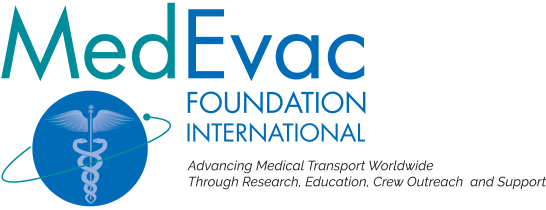Advancing Safety in Critical Care Transport
Outcomes of Adverse Events during Inter-facility Transports of Children in Ontario (2018), Janice A. Tijssen, MD. This grant is currently in process.
Sleep-Wake Patterns and Real-Time Fatigue Reduction in EMS Clinicians – Phase II (2015), P. Daniel Patterson, PhD, NRP, Frank Guyette, MD, Eileen Frazer, Doug Swanson, MD, Charity Moore, PhD. View Here
Sleep-Wake Patterns and Real-Time Fatigue Reduction in EMS Clinicians – Phase I (2014), P. Daniel Patterson, PhD, NRP, Frank Guyette, MD, Eileen Frazer, Doug Swanson, MD, Charity Moore, PhD. Published in American Journal of Industrial Medicine 2015.
View Here
Survivor Perceptions of Recovery Following an Air Medical Transport Accident (2012), There is a need for industry-level resources to guide management and organizational systems as they prepare for and respond to incident and accidents in the industry, Survivor’s Network and The Center for Medical Transport Research. Published in Prehospital Emergency Care 2014. View Here
Safe Emergency Transport of Neonatal Patients (2012), Nadine Levick MD, MPH.
Deviation and Validation of a Taxonomy to Categorize adverse Events and Near-misses in Transport Medicine (2008) Air Medical Transport is Associated with a Low Incidence of Adverse Events and Patient Harm, Russell MacDonald, MD. Published in Academic Emergency Medicine 2008. View Here
Webinar on Ambulance – Ground Transfer Safety (2009). Webinar Participants Learn How to Make Ground Ambulance Practices Safer, Niccole Alexander, MPP
Assessment of Cognitive Fatigue in Air Medical Providers (2009). Study found that shift length was not associated with changes in fatigue or cognitive function, Francis Guyette, MD. Published in Prehospital Emergency Care 2013. View Here
The Role of Digital Stories in Air Medical Transport Safety: Develop digital narratives and learn how to use them to influence behavior (2009). Digital Storytelling Used for Safety Education in Air Medical Transport, Cathy Jaynes, PhD, RN and Howard Werman, MD
The Effect of Sleep Inertia on EMS Pilot Performance (2009). Understanding the effects of sleep inertia on EMS pilots will enable strategies to develop to counter the effects of sleep inertia on pilot performance, thereby enhancing EMS safety, Frank Thomas, MD
Identification of the Incidence of Helicopter Shopping in Virginia (2008). Helicopter Shopping Identified, Quantified and Definition Called into Question through Web Enabled Software, Paul Davenport, RN, CMTE.
Helicopter and Fixed-Wing EMS – Water Survival and Egress Education (2008). Increasing Survival through Water Egress Training – H.B. Martz. This grant developed an educational component for presentation at the 2008 Air Medical Transport Conference (AMTC). The Water Egress Training course has been offered at each AMTC since.
Opportunities for Safety Improvement in HEMS: A Multi Discipline Safety Research Project (2008), Ira Blumen, MD, FACEP. This grant is currently in process.
Reporting and Analysis of Medical Transport Incidents and Accidents (2007), Eileen Frazer, RN, CMTE, CLNC. This grant is currently in process.
Assessment of EMS and Fire Department Knowledge of Landing zone Safety Before and after Viewing a Web-based Streaming Safety Video with Analysis of Knowledge Retention over Six Months (2007). Web-based Media Proven to be Effective in Teaching Landing Zone Safety, Marc A. Bellazzini, MD. Published in Air Medical Journal 2011. View Here
EMS Safety Attitudes Questionnaire (2007). Air-Medical Providers Rank First in Safety Culture Study, Daniel Patterson, MD and Henry Wang, MD. Published in Prehospital Emergency Care 2010. View Here
Weather Shopping Education for Pre-hospital and ED Requesting Agents – a Vision Zero Initiative (2007). Eliminate Helicopter Shopping Through Education, Eileen Frazer, RN, CMTE
Assessing Air Medical Crew Real-time Cognitive Readiness to Perform Critical Tasks (2006). Computer-based Psychological Test Shown to be Useful in Determining Flight Crew Readiness to Perform Critical Safety Tasks, Darren Braude, MD. Published in Prehospital Emergency Care 2011. View Here
Determinants of Safety – More results from the Pilots Survey of 2005 (2006). EMS Pilots Recommend CRM, NVG’s and Simulators to Enhance Safety, MarkAlain Dery, DO. Published in Air Medical Journal 2007. View Here
2005 Pilot Safety Survey – Narrative Response Analysis (2006) 11 Domains of Safety Identified by EMS Pilots in Safety Survey, Cathy Jaynes, PhD, RN
The Effects of Acute Stress on Paramedic Performance (2006). Specific Training May Help Advanced-care Paramedics Stay Calm Under Stress, Vicki LeBlanc, PhD. Published in Prehospital Disaster Medicine 2012. View Here
